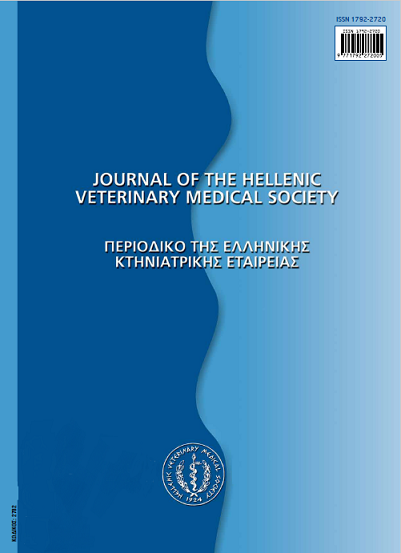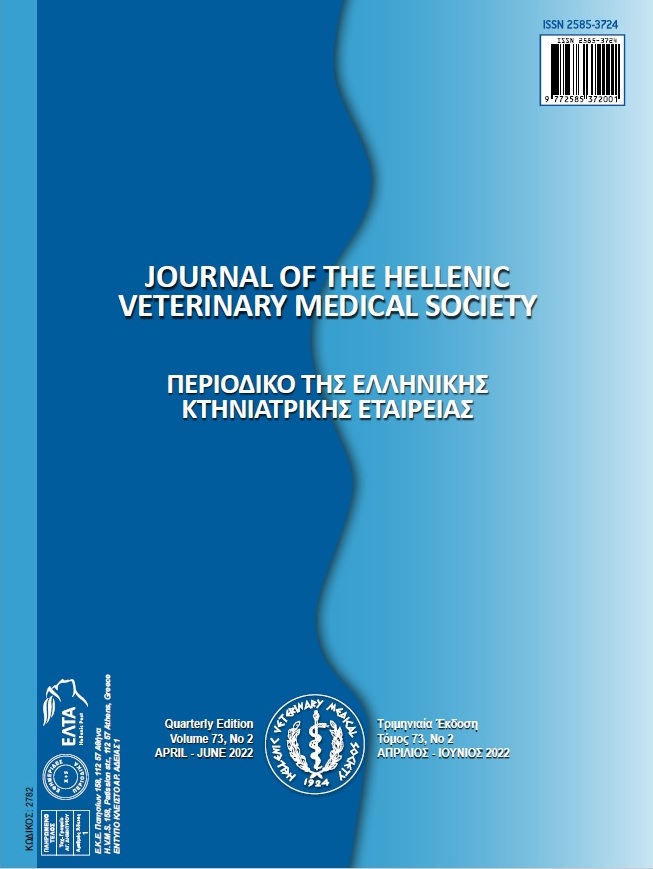Εκτίμηση της δράσης της τραμαδόλης στην αναλγησία και στην κινητικότα σε δύο διαφορετικά είδη εργαστηριακών μυών

Περίληψη
Η αναλγησία αποτελεί θέμα ιδιαίτερης σημασίας για τα ζώα εργαστηρίου τα οποία πρόκειται να υποβληθούν σε επώδυνους πειραματισμούς. Η επιλογή ενός αναλγητικού παράγοντα εξαρτάται μεταξύ των άλλων και από το μέγεθος και τη διάρκεια του επώδυνου ερεθίσματος αλλά και από την αποτελεσματικότητά του στον συγκεκριμένο οργανισμό. Η τραμαδόλη συμπεριλαμβανομένου του περιεγχειρητικού πόνου αποτελεί ένα γνωστό συνθετικό οπιοειδές αναλγητικό που χρησιμοποιείται τόσο για τον οξύ όσο και για τον χρόνιο πόνο. Σκοπός της μελέτης ήταν η εκτίμηση της αποτελεσματικότητας του συγκεκριμένου αναλγητικού σε δύο διαφορετικά είδη εργαστηριακών μυών μετά από ενδοπεριτοναϊκή χορήγηση. Τα ζώα που χρησιμοποιήθηκαν ήταν αρσενικά, ηλικίας 11-13 εβδομάδων, των φυλών C57BL/6J (n=39) και BALB/cJ (n=38). Τα ζώα χωρίστηκαν τυχαία σε ομάδες στις οποίες χορηγήθηκαν είτε φυσιολογικός ορός, είτε τραμαδόλη 10 mg/kg ή τραμαδόλη 40 mg/kg. Η αναλγησία μελετήθηκε με την υποβολή των ζώων στη δοκιμή της θερμαινόμενης πλάκας, για 30 και 60 λεπτά μετά τη χορήγηση της τραμαδόλης. Προκειμένου για τη δοκιμασία της θερμαινόμενης πλάκας, τα ζώα της φυλής BALB/cJ στα οποία χορηγήθηκε τραμαδόλη στη δοσολογία των 40 mg/kg εμφάνισαν καλύτερο επίπεδο αναλγησίας από τα αντίστοιχα ζώα της φυλής C57BL/6J. Η κινητικότητα των ζώων μελετήθηκε με τη δοκιμή ανοικτού πεδίου. Τα ζώα της φυλής BALB/cJ παρουσίασαν δοσοεξαρτώμενη μείωση της κινητικότητάς τους, ενώ τα ζώα της φυλής C57BL/6J παρουσίασαν έντονη υπερκινητικότητα στη δόση των 40 mg/kg τραμαδόλης. Συμπερασματικά χορήγηση τραμαδόλης στη δόση των 10 mg/kg δεν έχει καμμία επίδραση στο επίπεδο αναλγησίας για τα ζώα και των δύο φυλών. Προκειμένου για τη δόση των 40 mg/kg τραμαδόλης αυτή φαίνεται να έχει καλά αποτελέσματα για τα ζώα της φυλής BALB/cJ, ενώ για τα ζώα της φυλής C57BL/6J δεν θεωρείται κατάλληλη λόγω της προκαλούμενης υπερκινητικότητας στη δοκιμή ανοικτού πεδίου. Θα πρέπει να επισημανθεί ότι κατά τη διαδικασία επιλογής της τραμαδόλης ως αναλγητικού παράγοντα θα πρέπει να λαμβάνεται υπόψη όχι μόνο η δοσολογία αλλά και η φυλή του ζώου στο οποίο αυτή θα χορηγηθεί.
Λεπτομέρειες άρθρου
- Πώς να δημιουργήσετε Αναφορές
-
SYMEON, I., POLISSIDIS, A., BALAFAS, E., STASINOPOULOU, M., ALEXAKOS, P., VOYIATZAKI, C., & KOSTOMITSOPOULOS, N. (2018). Εκτίμηση της δράσης της τραμαδόλης στην αναλγησία και στην κινητικότα σε δύο διαφορετικά είδη εργαστηριακών μυών. Περιοδικό της Ελληνικής Κτηνιατρικής Εταιρείας, 68(1), 89–96. https://doi.org/10.12681/jhvms.15567
- Τεύχος
- Τόμ. 68 Αρ. 1 (2017)
- Ενότητα
- Research Articles

Αυτή η εργασία είναι αδειοδοτημένη υπό το CC Αναφορά Δημιουργού – Μη Εμπορική Χρήση 4.0.
Οι συγγραφείς των άρθρων που δημοσιεύονται στο περιοδικό διατηρούν τα δικαιώματα πνευματικής ιδιοκτησίας επί των άρθρων τους, δίνοντας στο περιοδικό το δικαίωμα της πρώτης δημοσίευσης.
Άρθρα που δημοσιεύονται στο περιοδικό διατίθενται με άδεια Creative Commons 4.0 Non Commercial και σύμφωνα με την άδεια μπορούν να χρησιμοποιούνται ελεύθερα, με αναφορά στο/στη συγγραφέα και στην πρώτη δημοσίευση για μη κερδοσκοπικούς σκοπούς.
Οι συγγραφείς μπορούν να καταθέσουν το άρθρο σε ιδρυματικό ή άλλο αποθετήριο ή/και να το δημοσιεύσουν σε άλλη έκδοση, με υποχρεωτική την αναφορά πρώτης δημοσίευσης στο J Hellenic Vet Med Soc
Οι συγγραφείς ενθαρρύνονται να καταθέσουν σε αποθετήριο ή να δημοσιεύσουν την εργασία τους στο διαδίκτυο πριν ή κατά τη διαδικασία υποβολής και αξιολόγησής της.



